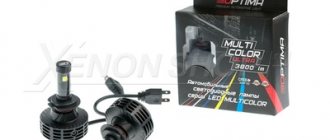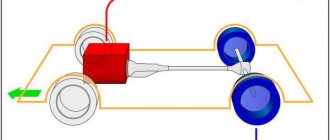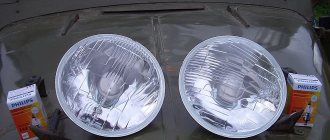Car lighting includes a lot of types of light bulbs, and each has its own functions and purpose. The lamps illuminate the interior, illuminate the glove compartment, trunk, engine, the dimensions warn of upcoming vehicle maneuvers, some are used as signal lamps, but there are the most important ones - for illuminating the road - headlights. A headlight is a part of the car, without which driving at night is almost impossible. The safety of the driver, the integrity of the car, as well as the health or life of the pedestrian depend on this device. Needless to say, the quality of the road surface leaves much to be desired: huge holes closer to the edge or many small holes in the middle of the road - both of them in any case kill the chassis, wheels, and shock absorbers. Therefore, you should carefully choose what type of lamps to install in the headlights: halogen, xenon or LED, and what is best suited to the specific operating conditions of the car.
Comparison of different types of headlights.
LED headlights vs xenon headlights: which is better?
Xenon and LED headlights no longer look like anything special. Today, this type of automotive optics has practically retired conventional classic halogen headlights, which cannot compete with new technologies. Many experts also believe that LED optics will also displace xenon lighting sources from the auto industry.
Is it so? Are LED headlights really better than xenon? Below we give you a comparison of two very different technologies, highlighting the pros and cons of each type of lighting.
What is bi-xenon
The disadvantages and advantages of xenon headlights are known to most car enthusiasts. But bi-xenon is a completely new phenomenon and not everyone is familiar with it.
Essentially, bi-xenon is a type of xenon lamp equipped with an additional mechanism with the ability to change the direction of the light flow. This design is a metal curtain that moves under the influence of a magnetic field, thus opening different areas of the lamp. Another structural type is the “floating” flask.
If we talk about comparing xenon and bi-xenon, then everything is quite simple. The former are installed separately for low and high beam, but the technology of the latter allows switching from one to the other.
Advantages and disadvantages of LED headlights:
LED headlights refer to optics that use LEDs as lighting sources. LEDs are widely used in the automotive industry today due to a number of advantages: brightness, rich light, low power consumption and long service life.
Advantages of LED car headlights
1. Energy saving: high efficiency and low power consumption. The energy utilization rate of the LED light source reaches 80% or more.
2. Environmental protection: no ultraviolet and infrared rays in the spectrum, no heat, no radiation, little glare, used lamps (waste) can be recycled, no pollution, no mercury, lamps can be touched, high quality light, environmentally friendly pure product.
See also: Car headlights: LED, halogen, xenon, laser and headlights of the future
3. Long service life: generally up to tens of thousands or even 100,000 hours. Some people think that if LEDs are used in car headlights, there will be no need to change LED optics for the entire life of the car.
4. High Brightness: LED brightness can reach 3500 lumens.
5. Small Size: Small size is another advantage. Thanks to the compact size of the diodes, designers have more freedom when creating headlight styling. Small size means more space for some design decisions when designing and creating optics. For example, thanks to the small size of LEDs, designers can outfit the headlight with a variety of compact, custom-sized lenses.
6. Stable and vibration-resistant: The structure of the LED headlight is simple. Typically, the headlight is surrounded by a clear epoxy resin seal. LED optics are well resistant to shocks and vibrations.
7. Fast Response: When LED lights turn on, there is an instant response (pause is only a few nanoseconds).
Disadvantages of LED lights
1. High cost: the cost is several times higher than the cost of a halogen lamp.
2. Heat dissipation: LED uses a diode light source, which is a cold light source that produces almost no heat. Nevertheless, heat is, of course, released. The board on which the diodes in the headlight are attached also heats up. Unfortunately, heat affects the lifespan of LED optics. As a result, the worse the heat dissipation system in the headlight, the shorter the service life of the optics.
3. No uniform standard: At present, there are no uniform relevant regulations for LED car headlights in the world. Production requirements are not clearly regulated, as a result of which many automakers currently do not particularly care about the quality of LED optics. As a result, the quality of LED products leaves much to be desired. This is why there are often cars on the market with factory defective LED optics.
4. High costs of retrofitting cars with LED optics: due to differences in the type of light emission, automakers have to spend a lot of money on retrofitting to equip xenon cars with LED optics. Unfortunately, these two technologies are not compatible. Even headlights with xenon lenses are not suitable for LED lamps. As a result, if a car manufacturer wants to equip any model with LED optics, it has to install completely different headlights, as well as electrical equipment related to the operation of LEDs.
5. Expensive and difficult to repair LED headlights: Unfortunately, most car dealers do not repair LED headlights.
Usually, if the LED optics in your car fail, the dealer offers to install a new headlight.
Advantages and disadvantages of xenon lamps
Xenon lamps are also called high-intensity discharge (HID) headlights. A xenon lamp produces an electric arc located in a glass bulb filled with xenon gas. As a result of the glow of the arc, the lamp produces bright white light, similar in spectrum to daylight sunlight. The color temperature of xenon lamps is in the range of 4200-6000K depending on the type and brand of lamps. Xenon lamps are installed in special lenses, which act as unique lenses, resulting in the visual effect of bright light becoming even better.
Advantages of xenon lamps
1. Excellent color temperature: HID lamp can produce 4000-12000 light color temperature (in Kelvin), which is close to the color of midday daylight. The human eye perceives the light of a xenon lamp comfortably.
2. High brightness: 35W xenon lamp can produce 3500 lumens (luminous intensity).
3. Compared with halogen lamps, xenon lighting sources consume less energy: the power of xenon lamps is usually only 35W, while the power of conventional halogen lamps is usually 55W. As a result, xenon lamps have greater energy savings than conventional halogen lighting sources.
4. Long service life: Xenon lamps have electronically excited gas, no tungsten wire, so the service life of xenon light sources is quite long. On average, xenon lamps can last about 3000 hours.
See also: Here's why LED traffic lights are unsafe
5. High stability: after a failure of the power supply system and battery, the xenon lamp ignition unit stops working, automatically turning off the lighting sources, thereby protecting them from voltage surges.
6. High level of safety: xenon lamps, in case of malfunction, do not go out instantly. So the driver will have time to pull over on the road at night.
Disadvantages of xenon lamps
1. Xenon lamps require an ignition unit and new wires: the use of a xenon lamp must be used with additional equipment. So, for xenon lamps to work, a voltage converter is needed that will increase 12 V to 23000 V.
2. Difficult installation: Installation of xenon headlights is more difficult compared to LED lights.
Currently, there are fewer and fewer cars with halogen headlights. Judging by the car market, automakers are increasingly opting for xenon or LED headlights. Automakers today use halogen light sources only when they want to save as much as possible on vehicle equipment, reducing its cost to a minimum. This is why you can still see predominantly halogen headlights on economy class cars today.
Nevertheless, increasingly, xenon and even LED lamps began to appear on inexpensive cars. But which light source is better - LEDs or xenon lamps? As we told you above, each lighting source has both its pros and cons. Automakers, naturally, are aware of all the shortcomings of modern car headlights and, of course, are constantly improving modern lighting sources, optimizing their physics.
Today, in many cars with xenon headlights, manufacturers most often use double lenses, which allow one bulb to work both on high beam and low beam. Moreover, modern technologies allow this to be done almost without delay.
Modern LED headlights have a technically integrated cooling system, which has significantly increased their service life in recent years. It is incorrect to compare which technology is better, since these are completely different technologies. To answer which lamps are better, it is necessary to compare not the technologies, but their actual effect. That is, you need to compare how the lamps illuminate the road at night.
See also: Types of headlights: Explanation
When comparing how a car with xenon lights the road at night with the low beams on, you can see how well the xenon lens generates bright xenon light. The distribution of the illumination range is uniform. The lighting effect of dark sections of the road is at a high level. True, there is a minus. In our example there is a sharp transition from dark to bright, which does not give a very good effect. That is, the illumination of the road has a sharp transition to a dark area, where xenon lamps no longer illuminate the road.
If you look at the low beam of an LED headlight, you will also see high and even brightness, illumination range, and light coverage width. But what is important is that with LED lighting there is no obvious phenomenon of attenuation of the light source. So in this example, LED headlights give a better effect than xenon.
When driving outside the city on an unlit road, the quality of high beams affects driving safety. When comparing the high beam performance of xenon and LED headlights, LED optics are better than xenon headlights. The LEDs continue to shine.
However, in terms of light penetration, LEDs are worse than xenon lamps. For example, on rainy and cloudy days, the actual illumination effect of LEDs will be significantly reduced compared to xenon optics.
If your car is equipped with halogen headlights, then you can retrofit it with xenon or even LED optics. But you must remember that in this case you will have to formalize changes to the design of the car, have the car tested in an accredited laboratory, and also make changes to the design of the cars in the registration documents at the State Traffic Safety Inspectorate.
See also: An American compared three types of headlights in a practical competition: Halogen, Xenon and LED
Naturally, such retrofitting of a car with modern optics, as well as its legalization, will cost a considerable amount. Without registration, driving such a car is prohibited by law. Remember that halogen headlights are not designed for xenon, much less LED, lamps. Under xenon or LEDs you need to install special lenses and headlight range control. Otherwise, you may be subject to administrative liability (including deprivation of your rights).
When choosing the color temperature of xenon lamps, you should not buy lamps with a color temperature higher than 6000 K. When the color temperature is more than 6000 K, the actual effect of xenon lighting is reduced, since the color of the xenon lamp will be closer to blue.
For the city, a color temperature of 4300 K to 5500 K is ideal. For suburban highways, 6000 K is more optimal.
However, keep in mind that in rain or fog, 6000 K lamps will have the opposite effect. So, ideally, install xenon lamps with a color temperature of no more than 4300-4500 K.
How is replacement carried out?
Installation of xenon headlights is possible only in the factory if this is provided for in the basic package. It is prohibited to install xenon car lamps yourself under Russian legislation.
There are often attempts to replace standard incandescent lamps in headlights with LED analogues.
There are a lot of advantages, but there are practically no disadvantages, besides the price. In this case, no restrictions are imposed, however, during the replacement process, participants in the process often encounter a number of difficulties:
- The LED is a source of directional light, which means that when installed in optics designed for incandescent lamps, the viewing angle will suffer. That is, the degree of side illumination will decrease significantly. As a solution to the problem, lamp manufacturers offer special bulbs with a crystal coating, which creates a diffused flow of light.
- Since LED devices react to voltage surges, powerful lamps require additional installation of current stabilizers.
Important! When replacing halogens with LEDs, you need to remember about the higher degree of heating of the latter. Temperature does not harm halogen devices, but LED lamps will need a ventilation system, which cannot always be “shoved” into the tight space of the headlights.
Bottom line
Xenon and LED headlights are not perfect, like everything in our world. Each technology has its pros and cons. So the final choice is yours. It all depends on your needs. The lifespan of LED headlights is definitely longer. For example, LEDs can last the entire life of the car. But this is ideal. However, due to imperfect technology, due to the lack of uniform standards and requirements for the production of LED optics, at the moment there are often factory defects in LED optics, which, unfortunately, can fail.
Moreover, most often it is not the LEDs themselves that fail, but the board from which they operate. Unfortunately, due to the design features of LED headlights, repairing them is often impractical. If LED optics are subject to repair, then it will cost a lot of money.
As for xenon, this technology is more proven and reliable. But xenon optics have disadvantages. For example, after several years of using xenon lamps, they begin to fade, which affects the brightness of the lighting. As a result, you will have to purchase two new lamps, which are not cheap.
From the point of view of the development of automotive optics, over time, of course, LED optics will most likely completely replace both halogen and xenon lighting sources. Currently, LED headlights are constantly being improved. Also, a number of automakers are developing newfangled laser headlight technology, which is already installed on some luxury cars today.
Laser headlights based on LED technology no longer have the same lighting quality disadvantages that conventional LED headlights have. Also recently, a number of manufacturers have begun using a new generation of matrix LED headlights, which also illuminate the road more efficiently.











